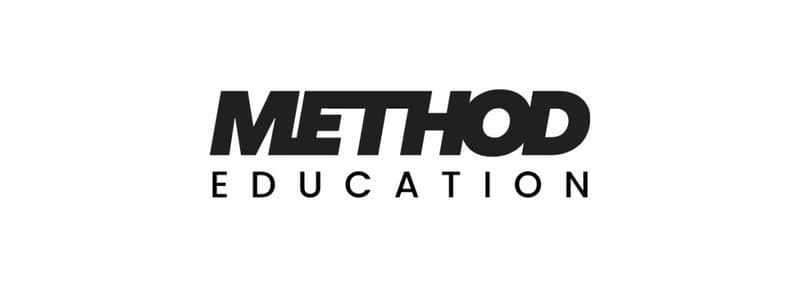Podcast
Questions and Answers
What happens if overloads occur during the recovery phase that are too great for systems to overcome?
What happens if overloads occur during the recovery phase that are too great for systems to overcome?
- An incomplete recovery with little adaptation results (correct)
- Complete recovery and adaptation occur
- Adaptive peaks are achieved quickly
- Overloads are beneficial for adaptation
What is the 'session-rest-session' paradigm in training?
What is the 'session-rest-session' paradigm in training?
It is a structured approach to training that involves alternating between stimulus (training) and sufficient rest (recovery and adaptation).
Adaptation is technically measured as the degree of performance gain above the starting _______.
Adaptation is technically measured as the degree of performance gain above the starting _______.
baseline
Match the following terms with their corresponding definitions:
Match the following terms with their corresponding definitions:
Smaller muscle lifts require longer recovery times than larger muscle lifts.
Smaller muscle lifts require longer recovery times than larger muscle lifts.
How often can small muscle lifts usually be trained per week?
How often can small muscle lifts usually be trained per week?
The quads have ___________ twitch characteristics, which somewhat mitigate the taxing nature of squats.
The quads have ___________ twitch characteristics, which somewhat mitigate the taxing nature of squats.
Match the following lifts with their recovery characteristics:
Match the following lifts with their recovery characteristics:
What is the optimal frequency of training for maximizing technical development?
What is the optimal frequency of training for maximizing technical development?
Hypertrophy training should consist of more than 4 sessions per week for the same muscle groups.
Hypertrophy training should consist of more than 4 sessions per week for the same muscle groups.
Training for peaking might occur only _____ a week for the same movement.
Training for peaking might occur only _____ a week for the same movement.
Match the training focus with its corresponding frequency:
Match the training focus with its corresponding frequency:
Which of the following best describes the consequence of training too infrequently?
Which of the following best describes the consequence of training too infrequently?
Higher training frequencies always yield better results for all lifters.
Higher training frequencies always yield better results for all lifters.
What is the primary factor that can determine the optimal training frequency for an individual lifter?
What is the primary factor that can determine the optimal training frequency for an individual lifter?
The term MRV stands for ______.
The term MRV stands for ______.
Match the following terms to their correct descriptions:
Match the following terms to their correct descriptions:
Flashcards
Overreaching
Overreaching
A training strategy where the body experiences a temporary disruption beyond its adaptive capacity.
Adaptation
Adaptation
The improvement in performance observed after a training stimulus, due to physiological changes.
Overload Training
Overload Training
Training that exceeds the body's current ability to recover and adapt.
Session-Rest-Adaptation (SRA) Principle
Session-Rest-Adaptation (SRA) Principle
Signup and view all the flashcards
Recovery
Recovery
Signup and view all the flashcards
Technique-focused training frequency
Technique-focused training frequency
Signup and view all the flashcards
Hypertrophy training frequency
Hypertrophy training frequency
Signup and view all the flashcards
Strength training frequency
Strength training frequency
Signup and view all the flashcards
Peak performance training frequency
Peak performance training frequency
Signup and view all the flashcards
Connective tissue recovery
Connective tissue recovery
Signup and view all the flashcards
SRA Curve Length
SRA Curve Length
Signup and view all the flashcards
Different Lift Recovery Times
Different Lift Recovery Times
Signup and view all the flashcards
Overreaching Risk
Overreaching Risk
Signup and view all the flashcards
Small Muscle Lifts Recovery
Small Muscle Lifts Recovery
Signup and view all the flashcards
Squat Recovery
Squat Recovery
Signup and view all the flashcards
Adaptive Dissipation
Adaptive Dissipation
Signup and view all the flashcards
Session-Rest-Adaptation (SRA) Curve
Session-Rest-Adaptation (SRA) Curve
Signup and view all the flashcards
Optimal Training Frequency
Optimal Training Frequency
Signup and view all the flashcards
Constraints on Training Frequency
Constraints on Training Frequency
Signup and view all the flashcards
Variety in Training Frequency
Variety in Training Frequency
Signup and view all the flashcards
Study Notes
Stimulus-Recovery-Adaptation (SRA)
- SRA describes the sequence of processes during and after training
- These processes lead to improvements in size and strength
- It's a sport science concept, derived from the General Adaptation Syndrome (GAS)
- SRA is crucial for every training session and the period before the next session
- The graph below visually represents the SRA cycle
Scientific Definition of Stimulus-Recovery-Adaptation
- Stimulus: The period of time during training when exercise causes disruption to the various systems in the body.
- Recovery: The period of time after the stimulus where systems return to a normal state after being disturbed by training
- Adaptation: The process that occurs when the body's systems adjust to the stimulus and recovery, resulting in improvements in size, strength, or performance.
- It's important to consider the nature of the disruption since performance can continue to decline hours and days after the stimulus itself.
- Muscle size reduction occurs after hard workouts as immune systems and satellite cells repair damaged muscle fibers.
- Similar processes happen in the nervous system (e.g., whole-movement performance can decrease for hours and days after intense training before recovering).
System-Specific SRA Curves
- Each SRA curve represents an averaging of multiple curves generated in each session.
- Different systems in the body experience their own SRA curves at individual timescales during training.
- Powerlifting training produces 4 distinct SRA curve types with different average timescales which include: nervous system technical ability, hypertrophy, nervous system force output, and fiber alignment/connective tissue integrity curves.
Nervous System: Technical Ability Curve
- Training improves the nervous system's ability to execute movements efficiently.
- Initial session and for hours after can impact technique.
- It may take a few hours for the nervous system to recover its ability to execute those certain patterns or movements.
Muscle Hypertrophy Curve
- Muscle size is the most important factor in strength.
- Muscle catabolism (breakdown) actually increases during training and size diminishes, but increases afterwards.
- The fractional synthetic rate of muscle growth (FSR) increases, and size return occurs after an overload session.
- SRA dynamics are important for powerlifting programs
Nervous System Force Output Curve
- The nervous system coordinates muscle contraction and relaxation to produce movement patterns.
- It also has the ability to control the magnitude of that movement.
- Experience impacts the force produced
- SRA curve for nervous system output may take a week to peak
Connective Tissue Integrity Curve
- Connective tissues like tendons and ligaments are damaged during training, and their recovery takes a considerable amount of time.
- The vascularity of tendon and ligaments is lower, which causes a slower recovery rate.
- A significant drop in connective tissue integrity in training can lead to weeks or even months.
- In order to get the best results when training connective tissues, it may be appropriate to alternate intense training periods with periods of less intense training.
Relative magnitudes of SRA curves & training frequencies
- Different types of training workouts produce different effects on various body systems.
- Each type of training will likely result in larger elevations than others
- Light Sessions Technique Practice: greatest magnitude of change
- Hypertrophy Training: greatest muscle growth
- Strength Training: greatest force production
- Peaking Training: greatest connective tissue reconstruction
Principle Importance Rank
- SRA is an important concept in powerlifting for optimal training, but it's not ranked as the highest-priority principle.
- Training at any reasonable frequency can generally improve all four systems, though possibly not to the greatest extent if the training protocol is not optimized.
- Both benefits and costs exist with improper structure of SRA curves and frequencies(a smaller negative versus violations of overload, and fatigue management)
Optimal Frequencies of Training
- The definition of SRA implies that several systems in the body experience their own unique timescales for adapting to training stimuli and recovering and then are ready to be loaded again.
- This concept is crucial for creating a training program that optimizes the growth and development of each system.
Training that is Too Clustered
- Overloading training sessions too soon after the previous session or very close to the next can interfere with performance and recovery.
- This is mainly due to an accumulation of fatigue from previous sessions
Training that is Too Low in Frequency
- If training is not frequent enough, the lifter might not reach all of their training goals.
- For specific systems, high frequencies are often necessary to optimize gains.
- An extreme lack of frequency and overtraining in the body is equally bad. It has a big negative effect on the adaptive magnitude of training.
Arrangement of Training Days
- The schedule or order of training sessions makes a difference in training's effectiveness.
- For example, training the lower body three times a week can be achieved in many different ways (Monday, Wednesday, Friday, or other days)
Studying That Suits You
Use AI to generate personalized quizzes and flashcards to suit your learning preferences.
Description
This quiz explores the concept of Stimulus-Recovery-Adaptation (SRA) in sports science. It covers the processes involved during and after training that lead to improvements in strength and performance. Understanding SRA is essential for optimizing training sessions and recovery periods.


